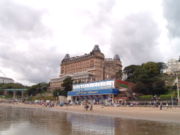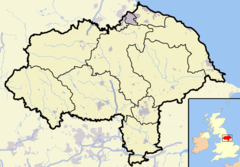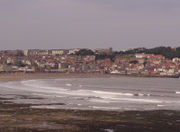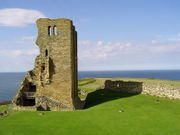Scarborough, North Yorkshire
From Wikipedia, the free encyclopedia
| Scarborough | |
|
Scarborough shown within North Yorkshire |
|
| Population | 50,135[1] |
|---|---|
| OS grid reference | |
| District | Scarborough |
| Shire county | North Yorkshire |
| Region | Yorkshire and the Humber |
| Constituent country | England |
| Sovereign state | United Kingdom |
| Post town | SCARBOROUGH |
| Postcode district | YO11, YO12, YO13 |
| Dialling code | 01723 |
| Police | North Yorkshire |
| Fire | North Yorkshire |
| Ambulance | Yorkshire |
| UK Parliament | Scarborough and Whitby |
| European Parliament | Yorkshire and the Humber |
| List of places: UK • England • Yorkshire | |
Scarborough is a town on the North Sea coast of North Yorkshire, England.
The modern town lies 30 to 70 metres above sea level, on limestone cliffs. The older part of the town lies around the harbour and is protected by a rocky headland. Scarborough is served by Scarborough railway station, with services from York on the North TransPennine route and from Hull on the Yorkshire Coast Line.
With a population of around 50,000, Scarborough is the largest holiday resort on the Yorkshire coast. It is home to residential communities, business, fishing and service industries, plus a growing digital and creative economy.
The town has a North Bay and a South Bay. The South Bay is the main focus and contains several arcades and entertainment facilities, and is overlooked by the town itself - popular locally for its shopping and nightlife. The harbour has undergone major regeneration including new pontoons and more pedestrian friendly promenade, street lighting and seating. The North Bay has traditionally been the more peaceful end of the resort and is home to Peasholm Park which has recently (June 2007) been restored to its Japanese-themed glory, complete with reconstructed pagoda. The park still features a mock maritime battle (based on the Battle of the River Plate) re-enacted on the boating lake with large model boats and fireworks throughout the summer holiday season. The North Bay Railway is a miniature railway which runs from the park to the Sea Life Centre at Scalby Mills.
The North Bay is linked to the South Bay by an extensive Victorian promenade, built around the headland. Overlooking both bays is Scarborough Castle, which was bombarded by the German warships SMS Derfflinger and SMS Von der Tann in the First World War. Both bays have popular sandy beaches and numerous rock-pools at low tide.
Slightly less well known is the South Cliff Promenade situated above the Spa and South Cliff Gardens, commanding excellent views of the South Bay and old town and where most of the postcard shots are taken. Its splendid Victorian styling is still intact and the mix of quality hotels and desirable apartments form the backdrop to the ITV drama The Royal which can often be seen filming in the area. The South Bay has the largest illuminated "Star Disk" anywhere in the UK. It is 26 metres across and is fitted with subterranean lights representing the 42 brightest stars and major constellations that can be seen from Scarborough in the northern skies.
To the south west of the town, beside the York to Scarborough railway line, is an ornamental lake known as the Mere. During the 20th century, the Mere was a popular park, with rowing boats, canoes and a miniature pirate ship - the Hispaniola - on which passengers were taken to "Treasure Island" to dig for doubloons. Since the late 1990s the emphasis has been on nature, and the lake is now part of the Oliver's Mount Country Park. The Hispaniola now sails out of the South bay.
As of 2007, Scarborough is the fourth most visited destination in the UK, after London, Manchester and Blackpool.
Contents[hide] |
[edit] History

The town was founded around 966 AD as Skarðaborg by Thorgils Skarthi, a Viking raider, though in the 4th century there had briefly been a Roman signal station on Scarborough Headland, and there is evidence of much earlier Stone Age and Bronze Age settlements. However, the new settlement was soon burned to the ground by a rival band of Vikings under Tosti, Lord of Falsgrave, and Harald III of Norway. The destruction and massacre meant that very little remained to be recorded in the Domesday survey of 1085. Scarborough recovered under King Henry II who built a stone castle on the headland, and granted charters in 1155 and 1163, permitting a market on the sands, and establishing rule by burgesses.
Edward II gave Scarborough Castle to his favourite, Piers Gaveston. In his castle at Scarborough, Gaveston was besieged by the barons, captured and carried to Oxford for execution.
In the Middle Ages, Scarborough Fair, permitted in a royal charter of 1253, held a six-week trading festival attracting merchants from all over Europe. It ran from Assumption Day, 15 August, until Michaelmas Day, the 29th September. The fair continued to be held for 500 years, from the 11th century to the 18th century, and is commemorated in the song Scarborough Fair:
- Are you going to Scarborough Fair?
- —parsley, sage, rosemary and thyme....
Scarborough and its castle changed hands seven times between Royalists and Parliamentarians during the English Civil War, of the 1640s, enduring two lengthy and violent sieges. Following the civil war, much of the town lay in ruins.
In 1626, Mrs Elizabeth Farrow discovered a stream of acidic water running from one of the cliffs to the south of the town. This gave birth to Scarborough Spa, and Dr Wittie's book about the spa waters published in 1660 attracted a flood of visitors to the town. Scarborough Spa became Britain's first seaside resort, though the first rolling bathing machines were not noted on the sands until 1735. The coming of the Scarborough-York railway in 1845 increased the tide of visitors.
This influx of visitors convinced a young architect (John Gibson) with an eye to the future to open Scarborough's first purpose-built hotel. In 1841 a railway link between York and Scarborough was being talked of and he decided that the area above the popular Spa building could be developed. He designed and laid the foundations of a ‘hotel’. (this was a new name derived from the word ‘hostel’ which would serve the same purpose but would be bigger and finer than the traditional inns). Gibson then passed the construction of this hotel to the newly formed South Cliff Building Company. On Tuesday, 10 June 1845 Scarborough's first hotel was opened—a marketing coup at the time, as the Grand Hotel, soon to be Europe's largest, was not yet finished. When John Fairgray Sharpin came to visit Scarborough in 1845, he was charmed at first sight.
When the Grand Hotel was completed in 1867 it was one of the largest hotels in the world and one of the first giant purpose-built hotels in Europe. Four towers represent the seasons, 12 floors represent the months, 52 chimneys represent the weeks and originally 365 bedrooms represented the days of the year. A blue plaque outside marks where the novelist Anne Brontë died in 1849.
During World War I, the town was bombarded by German warships of the High Seas Fleet, an act which shocked the British.
In June 1993 Scarborough made headlines around the world when a landslip caused part of the Holbeck Hall Hotel, along with its gardens, to fall into the sea. Although the slip was shored up with rocks and the land has long since grassed over, evidence of the cliff's collapse remains clearly visible from The Esplanade, near Shuttleworth Gardens.
Scarborough is one of Yorkshire's 'renaissance towns', having been granted government support for securing a vibrant future. As a result there are many building projects to renovate classic Victorian buildings and quality contemporary architecture.
[edit] Culture
Dramatist Alan Ayckbourn is based in Scarborough where he has lived for a number of years. He has produced some sixty plays in Scarborough and is the artistic director of the famous Stephen Joseph Theatre, where almost all his plays receive their first performance. The town also plays host to the annual National Student Drama Festival, which takes place at the Stephen Joseph Theatre, the Spa Centre and other venues around the town. The Futurist Theatre is a theatre and cinema on the seafront of the South Bay.
The Grade II listed Scarborough Spa complex is home to the Scarborough Spa Orchestra, the last remaining seaside orchestra in the UK. The orchestra gives 10 concerts every week during the summer months, playing music from an extensive repertoire of classical and light music with no programme repeats.
The area is also home to hundreds of "artists" working in a wide variety of media and boasts several galleries. The presence of the University of Hull Digital Arts and Yorkshire Coast College's Arts provision in the town help fuel a vibrant music and arts scene.
In recent years, arts, business and education have collaborated annually to produce Digital Scarborough - a celebration of the town's digital activities including a wide range of events from business networking to film showings and gigs with DJs and VJs.
The town is home to a significant jazz festival each September and in the summer boasts 'Beached' - an eclectic rock and pop festival which takes place on the South Bay beach and features at least 50% local talent alongside internationally known artists. In summer 2005, Scarborough played host to the Sonic Arts Network Expo featuring cutting-edge performances and installations.
These fairly recent developments, married to a long-established museum and visual arts facilities, hint at Scarborough's desire to re-invent itself as a creative and arts-based town. In 2006 work started on Wood End Museum - former home to the Sitwells—to convert it into a creative centre including workspace for artists and the digital cluster, plus an exhibition space. The town's Rotunda Museum is currently undergoing a multi-million-pound redevelopment that will see it become a national centre for geology. 2006 also saw the formation of a creative industries network called 'Creative Coast comprising artists, designers, writers and other creatives with the shared vision of a culturally vibrant economy on the North Yorkshire coast. [1]
Scarborough also has a considerable graffiti culture, with as many as 20 'writers' currently active. There are two areas where graffiti art is legal in Scarborough, Sainsbury's Basketball Courts, and Falsgrave Park Wall. Both have seen many collaborations and murals.
The films Little Voice and A Chorus of Disapproval were filmed on location in Scarborough and the surrounding area. Other films that have filmed scenes in Scarborough include Miranda and Beltenbros. [2][3]
Scarborough is twinned with Osterode am Harz and Cahir.
[edit] Education
The town has a small higher education institution, the University of Hull, Scarborough Campus, (formerly North Riding College and University College Scarborough) and is home to Yorkshire Coast College and Scarborough Sixth Form College. The five main state secondary schools in Scarborough are Graham School, Raincliffe School, Scalby School, Pindar School and St Augustine's Roman Catholic School, the last being rated as outstanding in a recent Ofsted report. There are also two private schools, Scarborough College (for ages 3 to 18 years) and Bramcote (ages 4 to 13 years). Scarborough College recently abolished A-levels and next year will go over to the International Baccalaureate (IB).
Education in Scarborough is notable for its commitment to the digital economy with 2006 seeing the formation of the University of Hull's School of Arts and New Media at the Scarborough Campus. Scarborough is one of the UK mainland's first wireless campuses. [4].
[edit] Sport
The Scarborough Amateur Rowing Club was founded in May 1869, and is the oldest surviving rowing club on the north-east coast. For more than 100 years, sea rowing has taken place on the Yorkshire coast between the Tees and the Humber. Beginning with friendly rivalry between the fishermen and the jet miners from Blyth (The German Ocean Race), the sport has progressed to what it is today. More recent successes for the club include, Bob Hewitt who now competes as a lightweight rower for the national team. Also in 2006 the club finally won the acclaimed Wilson's Cup, up until then held by club rivals in neibouring town Whitby for over half a century. Rowing takes place throughout the summer months.
Scarborough is home to the Oliver's Mount racing circuit. This track is composed of twisty public roads and has played host to domestic motorcycling and rallying events for many years. Noted motorcycle racers who have raced at Oliver's Mount include Barry Sheene and Ron Haslam.
Scarborough Cricket Club has won the ECB National Club Cricket Championship at Lord's, on five occasions between 1972 and 1982, a record number of victories. The club also hosts the annual Scarborough Cricket Festival, and Yorkshire County Cricket Club uses North Marine Road (Scarborough) for a selection of home fixtures throughout the season.
The former Scarborough Football Club enjoyed a career in the Football League during the 1990s before being relegated to the Conference North in 2006 and to the Northern Premier League the following year. One of its greatest achievements was winning the FA Trophy at Wembley Stadium, on three occasions. The club's best FA Cup performance was in January 2004 when matched against Chelsea in the 4th round. Chelsea narrowly won by 1-0 from a John Terry header. Scarborough F.C. was wound up on 20 June 2007 from unpaid debts exceeding £2 million [5]. A new club, Scarborough Athletic was formed shortly afterwards. While the team is currently playing its home matches in neighbouring Bridlington, they hope to return to Scarborough in the near future.
[edit] Economy
As might be expected in a significant coastal town, Scarborough's fishing industry is still active, though only a shadow of its former self. The working harbour is home to a fish market including a shop and wooden stalls where fresh, locally caught seafood can be purchased by the public.
The tourism trade continues to be a major part of the local economy despite the current affordability of foreign holidays. While weekend and mid-week-break trade are tending to replace the traditional week-long family holiday, the beaches and attractions are always very busy throughout summer - a marked contrast to the quieter winter months when Scarborough is often seen as a peaceful bolt-hole from cities such as Leeds and Bradford. Confidence in the hospitality industry is high, evidenced by major refits in recent years, often targeted at a higher-spending clientele. Significant amongst these is the Grand, Scarborough's biggest hotel, which overlooks the South Bay.
Scarborough's town centre has major shopping chains (Debenhams, Marks & Spencer, TK Maxx, Matalan, etc.) alongside boutique shops. As well as a main shopping centre and the Brunswick shopping centre, the town has an indoor market with a large range of antique shops and independent traders in its vaults.
The printing industry is well represented with major players Pindar and Polestar both having bases on the business park. Pindar, which also owns the AlphaGraphics chain, is a Scarborough-born company with an international profile. Thanks in part to one of the first internet computing degree courses being available at the Scarborough campus of the University of Hull, the local creative industries include a good selection of website design and development businesses. The firm of Plaxtons has been building coaches and buses since 1907 and is still one of Scarborough's largest employers.
The Castle ward was for many years affected by significant unemployment which had, however, fallen to 7.68%[2] at the time of the 2001 census.
[edit] Famous residents and ex-residents
- John Atkinson Grimshaw, artist
- Alan Ayckbourn, playwright
- Vincent Billington, International Concert Pianist, Radio 3
- Anne Brontë, writer, died on holiday in Scarborough
- Joy Brook, played Wpc Kerry Holmes in The Bill
- Colin Challen, MP for Morley and Rothwell – born in Scarborough
- Liz Dawn, 'Vera Duckworth' in Coronation Street – had a holiday home in Scarborough
- Richard Dunn, former World Heavyweight title contender
- Ben Ellis, contestant on BBC's Any Dream Will Do
- Fred Feast, actor – formerly of Coronation Street (Fred Gee)
- Eric Fenby, 20th century composer and amanuensis of Frederick Delius
- Jonathan Greening, footballer with Championship side West Bromwich Albion
- Edward James Harland, shipbuilding, co-founder of Harland and Wolff
- Malcolm Hebden, 'Norris Cole' in Coronation Street
- Susan Hill, author
- Peter Hough, founder of Scarborough Pottery
- Paul Ingle, former IBF Featherweight Champion
- Ben Kingsley, actor – born in Scarborough, 1943
- Charles Laughton, actor and director
- Frederic Leighton, 1st Baron Leighton, painter and sculptor
- Little Angels, British Rock Group 1980's and 1990's
- James Martin (chef), attended Yorkshire Coast College
- Bill Nicholson, manager of Tottenham Hotspur when they completed the Football League First Division and FA Cup double in 1960-61
- Mary Nightingale, Presenter of ITV News
- Wilfred Owen, World War I poet – convalesced in Scarborough
- Robert Palmer, singer
- Mark Richardson, musician in the rock band Feeder
- Joel Ross, one half of BBC Radio 1 duo JK and Joel
- Sir Jimmy Savile, television and radio personality
- The Sitwell family, literary circle
- William Smith (geologist), inspiration behind the Rotunda Museum, built in 1828
- Jon Snow, Channel 4 News presenter, attended Yorkshire Coast College
- Graham Taylor (author), writer of the Shadowmancer series
- Peter Taylor (Journalist), former presenter of Panorama (television)
- Paul Tonkinson, comedian
- Fred Trueman, Yorkshire County Cricket Club legend. Lived in the town for 17 years
- Craig White, Yorkshire Cricketer, lives in the Borough
- Michael Wilson (journalist), Business editor for Sky News
- Penelope Wilton, Actress, star of Clockwise (movie)
[edit] References
- ^ Scarborough Borough Council, 2001 census information
- ^ Neighbourhood Statistics - Area: Castle (Ward). Office for National Statistics. Retrieved on 2007-07-08.
[edit] See also
- A writer's resort (N.Y. Times)
- The Scarborough Evening News
- Scarborough railway station
- Soundwave Festival
- Scarborough Castle
- Scarborough Fair
- Beached Festival
- Scarborough North Bay Railway
[edit] External links
| The external links in this article may not comply with Wikipedia's content policies. Please improve this article by removing excessive or inappropriate external links. |
- Official Website of Scarborough Borough
- The last remaining seaside orchestra in the UK
- - Guide to Scarborough
- - History timeline of Scarborough
- Creative Coast - The North Yorkshire Coast's Creative Industries Network
- Digital Scarborough - Business, Arts & Education Event
- National Student Drama Festival
- Scarborough Special Events Group - SSEG, Amateur Radio group for Scarborough's special events.
- St Marys Church — Scarborough
- - Anne Bronte remembered in Scarborough
- - Info on Scarborough Lighthouse
- Scarborough's Future
- Stephen Joseph Theatre - Scarborough
- Sonic Arts Network & Expo Festival
- Scarborough Museums and Art Gallery
- Scarborough's First Hotel
- Scarborough Yorkshire Online
- Scarborough Field Naturalists' Society
- Visitor's Guide to Scarborough









